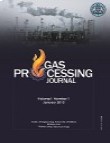Energy and Environmental Comparison of Different Scenarios for Cogeneration of Power and Desalinated Water in Iran
Author(s):
Article Type:
Research/Original Article (دارای رتبه معتبر)
Abstract:
This paper presents a combined thermodynamic, economic, and environmental comparison of different configurations for co-production of power and desalinated water. Each configuration is analyzed both with inlet air cooling and without inlet air cooling. The most eminent characteristics for the comparison are cost of produced power, cost of produced water, total annual profit, CO2 emission, and CHP efficiency. The common portions of all configurations are the gas turbine and the desalination system. The primary distinctions between scenarios are arrangement and type of system components. Thermodynamic simulation determines mass flow rate of high pressure and low pressure steam, as well as net power and water production of each configuration. Economic simulation reveals the price of produced power, the price of produced water and the total annual profit of the plant. Also, Environmental analysis specifies the total CO2 emission per annum. Final results show that the third configuration, in which a double-pressure HRSG is utilized, has the lowest CO2 emission per MWh of produced electricity. Also, it is concluded that the second configuration, in which a single-pressure HRSG is utilized, has the lowest specific fuel consumption and consequently the highest CHP efficiency. Sensitivity analysis shows that increasing the inlet air temperature will increase the specific CO2 emission in the second configuration. On the other hand, inlet air temperature increase has a marginal impact on CO2 emission in the first and the third configurations. The economic analysis shows that the first scenario with inlet air cooling has the highest total annual profit.
Keywords:
Language:
English
Published:
Gas Processing Journal, Volume:9 Issue: 1, Spring 2021
Pages:
29 to 42
https://magiran.com/p2241325


